
|
|
|
|
|
|
Classic Bikes
Custom Bikes
Individual
Racing Bikes AJP
AJS
Aprilia
Ariel
Avinton / Wakan
Bajaj
Benelli
Beta
Bimota
BMW
Brough Superior
BRP Cam-Am
BSA
Buell / EBR
Bultaco
Cagiva
Campagna
CCM
CF Moto
Combat Motors
Derbi
Deus
Ducati
Excelsior
GASGAS
Ghezzi Brian
Gilera
GIMA
Harley Davidson
Hero
Highland
Honda
Horex
Husaberg
Husqvarna
Hyosung
Indian
Jawa
Kawasaki
KTM
KYMCO
Laverda
Lazareth
Magni
Maico
Mash
Matchless
Mondial
Moto Guzzi
Moto Morini
MV Agusta
MZ / MuZ
NCR
Norton
NSU
Paton
Peugeot
Piaggio
Revival Cycles
Roland Sands
Royal Enfield
Sachs
Sherco
Sunbeam
Suzuki
SWM
SYM
Triumph
TVS
Ural
Velocette
Vespa
Victory
Vincent
VOR
Voxan
Vyrus
Walt Siegl
Walz
Wrenchmonkees
Wunderlich
XTR / Radical
Yamaha
Zero
Video
Technical
Complete Manufacturer List
|
Honda CBR1000RR-R Fireblade SP |
| . |
|
Make Model |
Honda CBR1000RR-R Fireblade SP |
|
Year |
2020 |
|
Engine |
Four stroke, transverse 4 cylinder, DOHC, 4 valves per cylinder |
|
Capacity |
999.9 cc / 61 cu-in |
|
Bore x Stroke |
81 x 48.5 mm |
|
Compression Ratio |
13.0:1 |
|
Cooling System |
Liquid cooled |
|
Exhaust |
Titanium Akrapovič |
|
Induction |
Programmed Dual Stage Fuel Injection (PGM-DSFI) with 52mm throttle bodies, Denso 12-hole injectors |
|
Ignition |
Digital transistorized with electronic advance |
|
Battery |
12-6 YTZ7S |
|
Starting |
Electric |
|
Max Power |
215 hp / 160kW @ 14500 |
|
Max Torque |
113 Nm / 83 lb-ft @ 12500 |
|
Clutch |
Wet, multiplate hydraulic clutch with assist slipper |
|
Transmission |
6 speed |
|
Final Drive |
#525 Chain, 16T/43T |
|
Frame |
Twin-spar aluminum |
|
Front Suspension |
43mm Öhlins NPX Smart-EC Front Fork with electronically-controlled preload, compression and rebound adjustments |
|
Front Wheel Travel |
110 mm / 4.3 in |
|
Rear Suspension |
Pro-Link® system; single Öhlins shock w/ Electronic Control (S-EC) |
|
Rear Wheel Travel |
142 mm / 5.6 in |
|
Front Brakes |
2x 330mm discs w/ radially mounted 4-piston Brembo Stylema calipers |
|
Rear Brakes |
Single 220mm disc w/ 2-piston Brembo caliper |
|
ABS System |
Standard |
|
Wheels |
Cast aluminum |
|
Front Tyre |
120/70ZR17 |
|
Rear Tyre |
200/55ZR17 |
|
Rake |
24° |
|
Trail |
101.6 mm / 4 in |
|
Dimensions |
Length 2100 mm / 82.7 in |
|
Wheelbase |
1455 mm / 57.3 in |
|
Seat Height |
828 mm / 32.6 in |
|
Ground Clearance |
115 mm / 4.5 in |
|
Wet Weight |
201 kg / 443 lbs |
|
Fuel Capacity |
16 Litres / 4.3 US gal |
| . |
Focusing on outright track performance, engineers have developed the CBR1000RR-R Fireblade SP with engine and chassis technology from MotoGP, the all-new model drawing heavily on the RCV combustion efficiency and low-friction solutions. The engine is more compact than the inline four-cylinder powerplant it replaces and benefits from the use of high-end technologies like titanium connecting rods, forged aluminum pistons and finger-follower rocker arms.
The CBR1000RR-R Fireblade SP uses an all-new aluminum diamond frame with increased vertical and torsional rigidity, but decreased horizontal rigidity, for maximum levels of grip and feel. A longer swingarm—stamped from aluminum of 18 individual thicknesses—is developed with lessons learned through Honda’s Grand Prix efforts, further highlighting the connection between the all-new model and Honda’s championship-winning race bikes.
Honda Selectable Torque Control (HSTC) has been optimized and an adjustable Start Mode joins Power, Engine Brake and Wheelie Control; a quick shifter is standard. The CBR1000RR-R Fireblade SP is outfitted with a six-axis Inertial Measurement Unit (IMU), three-level Honda Electronic Steering Damper (HESD) and second-generation Öhlins Smart Electronic Control (S-EC) suspension and user interface. New Brembo Stylema brake calipers bite 330mm rotors through two-level ABS. The bodywork and riding position have an uncompromising focus on aerodynamic performance, and the fairing features MotoGP-derived winglets to generate downforce. A full-color TFT screen and Honda Smart Key are the finishing touches.
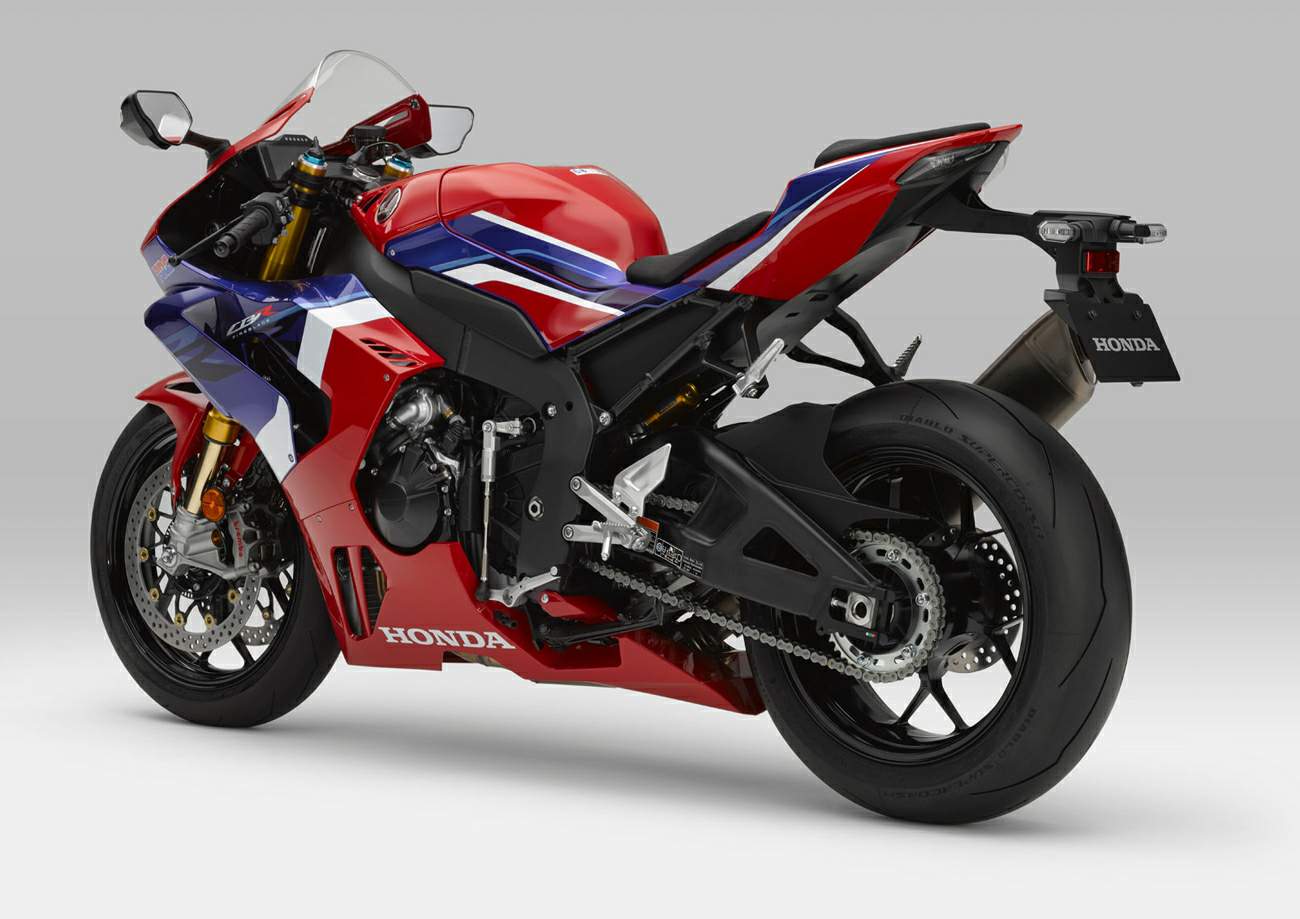
EVERYTHING BUT THE FACTORY CONTRACT
What you see here is the best of the best, the most exclusive, feature-rich open-class sportbike Honda has ever built under the CBR banner. Introducing the limited edition CBR1000RR-R Fireblade SP. Street legal, but track ready. Offering a degree of performance and refinement you’ve likely never experienced—unless you’ve had a factory ride. Available to only a handful of lucky riders. And it still offers Honda’s famous CBR refinement, build quality, and rideability. Get ready to find out why world champions like Marc Márquez ride red. And why you should too.
HISTORY
The CBR1000RR-R SP descends from a magnificent racing pedigree that has played a key role in the advancement of the sport bike genre. The bloodline starts with the 1959 Honda CB92 Benly Super Sport, a race-worthy performance model that competed at the highest levels on the track while being equally at home when ridden on the road, establishing a protocol that Honda sport bikes have championed ever since. The steadfast pursuit of technological improvement while competing on the World Championship stage cultivated a number of seminal models in the successive decades, including the groundbreaking 1969 CB750, which introduced the world’s first modern inline four-cylinder sport bike engine—an architecture quickly imitated by the competition.
The pace-setting development continued as the CBR family shifted the paradigm yet again. In the 1990s, the CBR400RR and CBR900RR ushered in the concept of “Total Control,” an ideal blend of harmonious engine performance, light weight and nimble handling that dramatically enhances the connection between rider and machine. Introduced in 2004, the CBR1000RR has continued to refine this well-proven theory by incorporating lessons learned from Honda’s MotoGP championship-winning RC models on racing circuits around the globe. The CBR1000RR has continuously raised the bar in the 1000cc sport bike category. Drawing heavily from Honda’s dominant RCV MotoGP platform, the 2021 CBR1000RR-R Fireblade SP will definitely reset it again.
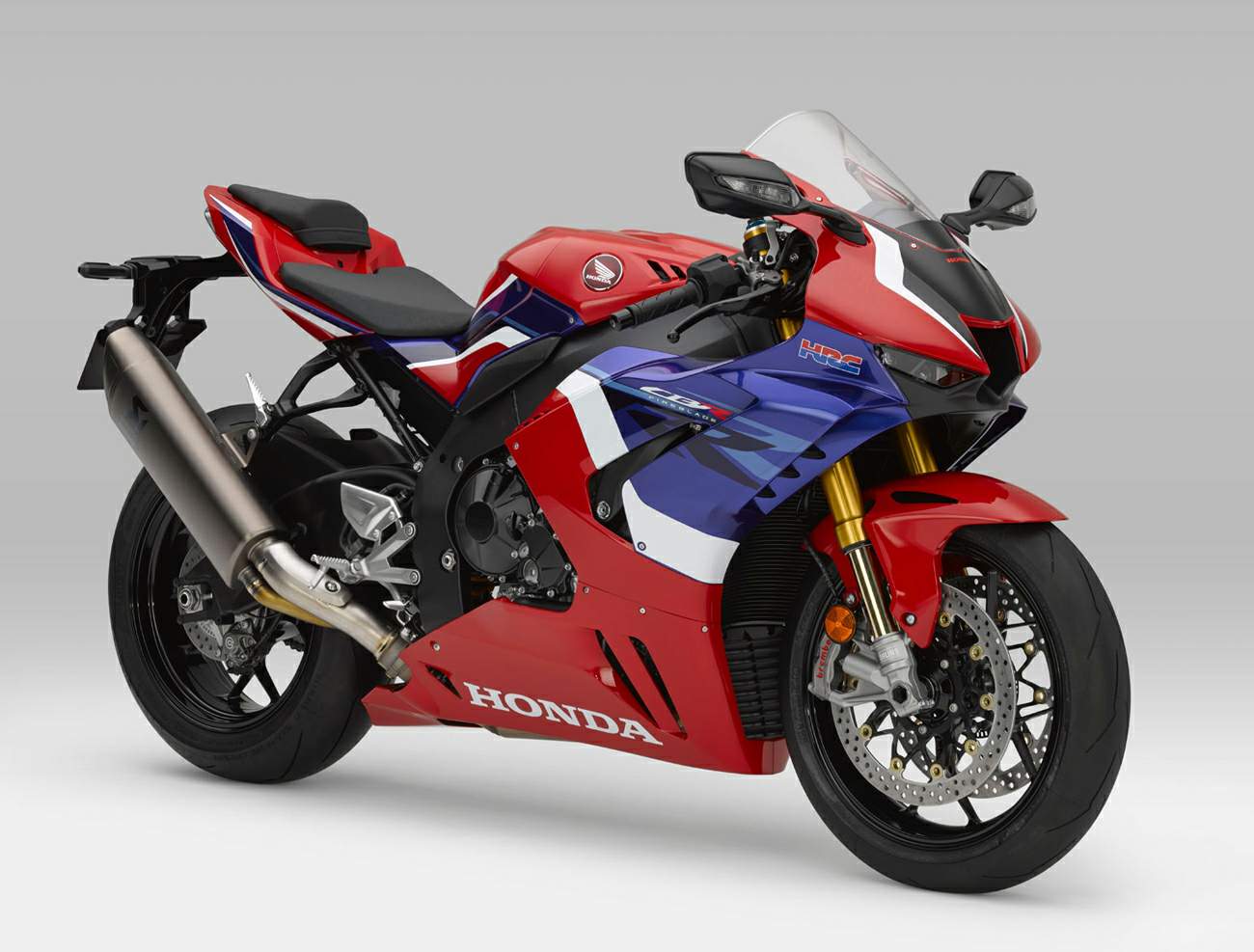
ENGINE / DRIVETRAIN
Sharing a close kinship with Honda’s legendary RCV MotoGP platform, the CBR100RR-R Fireblade SP’s all-new inline four-cylinder engine has been engineered with increased focus on track performance while delivering unprecedented levels of rider control. It’s more compact than ever before and also more powerful.
Combustion efficiency and friction reduction are key attributes of the new engine, which now features the same “over square” 81 mm bore and 48.5 mm stroke as the RC213V-S. A radical change from the 76 mm x 55 mm of the previous generation, the new dimensions give the CBR1000RR-R Fireblade SP the largest bore size among inline four-cylinder 1000cc machines. The valve actuation incorporates new finger-follower rocker arms, doing away with the shim-under-bucket design of the previous valve train, reducing inertial weight by approximately 75%. Diamond Like Carbon (DLC) on the cam lobes—just like the RC213V-S—is a first for mass-production motorcycles and reduce valvetrain friction by 35% compared to non-DLC-coated lobes, for increased power. The valve train is driven by a new (patent pending) semi-cam gear-train system in which the cam chain is driven by the timing gear located on the crankshaft via the cam-idle gear, making it shorter in length.
The CBR1000RR-R Fireblade SP’s reciprocating group has also been improved. The crank journals are larger and the crankcase wall thickness has been optimized to increase rigidity and resist deflection. Reciprocating mass is also decreased, thanks to forged, lightweight TI-64A Titanium connecting rods and connecting-rod caps that are 50% lighter than Chromium Molybdenum steel versions (the material was developed by Honda). The rods also employ HB 149 Chromium Molybdenum Vanadium (Cr-Mo-V, again a Honda development) steel-bolt design that eliminates the need for fastening nuts. To ensure durability, the same internal friction-reduction methods found on the RC213V-S are utilized. The small-end bushings are made of shaved C1720-HT Beryllium copper (because of its high-rpm reliability), while the surfaces of the big-ends are also DLC-coated.
The CBR1000RR-R Fireblade SP also features new pistons forged from A2618 aluminum (the same as the RC213V-S) for light weight, strength and durability. Each piston is 5% lighter than those found in the previous version, and the piston skirts now feature an Ober coating (Teflon and Molybdenum base) and nickel-phosphorous plating in the piston-pin clip-groove for increased high-rpm wear resistance.

To maximize thermal efficiency and piston durability, the pistons use a multi-point piston jet that sprays cooling oil in multiple directions through each cycle. At low rpm—i.e., when they’re not needed—check balls within the jets shut off the flow of oil in order to limit oil-pressure loss, thereby minimizing friction.
Air Management The engine is fed through a ram-air duct located at the high-surface-pressure tip of the front fairing. (It’s identical in size to the opening found on the RC213V MotoGP machine.) A ribbed “turbulator” to the right, left and above the duct entrance ensures maximum induction of moving air with minimal impact on handling. The draft angle of the interior opening maintains optimal flow under high speed and acceleration.
To maintain stable performance across a wide speed range, the pressurized airstream is routed straight shot through the headstock, around the steering stem and into the airbox. This smooth path is made possible by the application of Honda’s Smart Key system (dispensing with a traditionally mounted ignition barrel), and the new chassis’ 25° steering angle.
Further ensuring even airflow, the upstream side of the air filter has been enlarged to lower airflow speed, and it’s also 25% larger than the previous design and angled for an even flow. Once past the filter, air changes direction into the largest volume of the airbox and—along with fuel—feeds an eccentric bell-mouth funnel. The result is reduced drop in intake air pressure and more efficient breathing for greater performance.
The CBR1000RR-R Fireblade SP also features new 52 mm throttle bodies, a 4 mm increase in diameter compared to the previous model. An oval internal cross section makes for smooth flow (further reducing intake pressure drop) from the throttle butterfly valves to the inlet valves.
The valve angle on the intake side has been reduced from 11° to 9°, improving combustion efficiency by reducing the surface area of the combustion chamber. The gas-flow efficiency of the intake ports is increased by approximately 2%. To improve throttle response, the port volume (the capacity between throttle butterfly valves and intake-valve seat) has been reduced 13%, and the throttle shaft is now constructed from highly rigid stainless steel (as opposed to brass), reducing deflection and operational friction. This “Total Control” design initiative results in throttle response that is more directly connected to the rider’s right hand.
Minimizing friction elsewhere in the engine was a key focus in obtaining increased high-rpm power. To reduce bore distortion (and thus friction), the cylinder features a new, patent-pending, built-in bottom bypass that circulates cool water from the radiator into the main water jacket, while the area below uses non-cooled water. The net effect is lower and more even temperature at all points across the bores. The new system also eliminates one external hose, increasing efficiency.
The new engine cases are shorter in length, thanks to a reduced distance between the crankshaft, countershaft and main shafts. The rear of the engine block also serves as the upper shock mount. In addition to being longitudinally shorter, the cases are also narrower. Honda engineers achieved this by revising the starting system to start the engine via rotation of the clutch main shaft rather than the crankshaft. This patent-pending design allows for a more compact crankshaft and gives the primary driven gear double utility, as it transmits torque from the starter motor. The primary gear is now smaller and features fewer teeth, saving even more space.
Exhaust The CBR1000RR-R Fireblade SP’s new exhaust system is also re-engineered. Its optimized downpipes incorporate an oval cross section for improved exhaust-gas flow. The catalyzer unit is 10mm larger in diameter to reduce exhaust-pressure drop, but total unit weight increase is negligible due to a revised wall thickness.
Developed in partnership with aftermarket exhaust system manufacturer Akrapovič, the titanium muffler is small and lightweight, further improving mass centralization and allowing greater right-side lean angle. The muffler features an exhaust valve designed with Akrapovič to deliver both low-rpm torque and high-rpm power; a valve stopper (patent-pending) prevents exhaust-gas leakage when closed, to reduce noise. Internal muffler volume is reduced by 38% compared to the previous design.
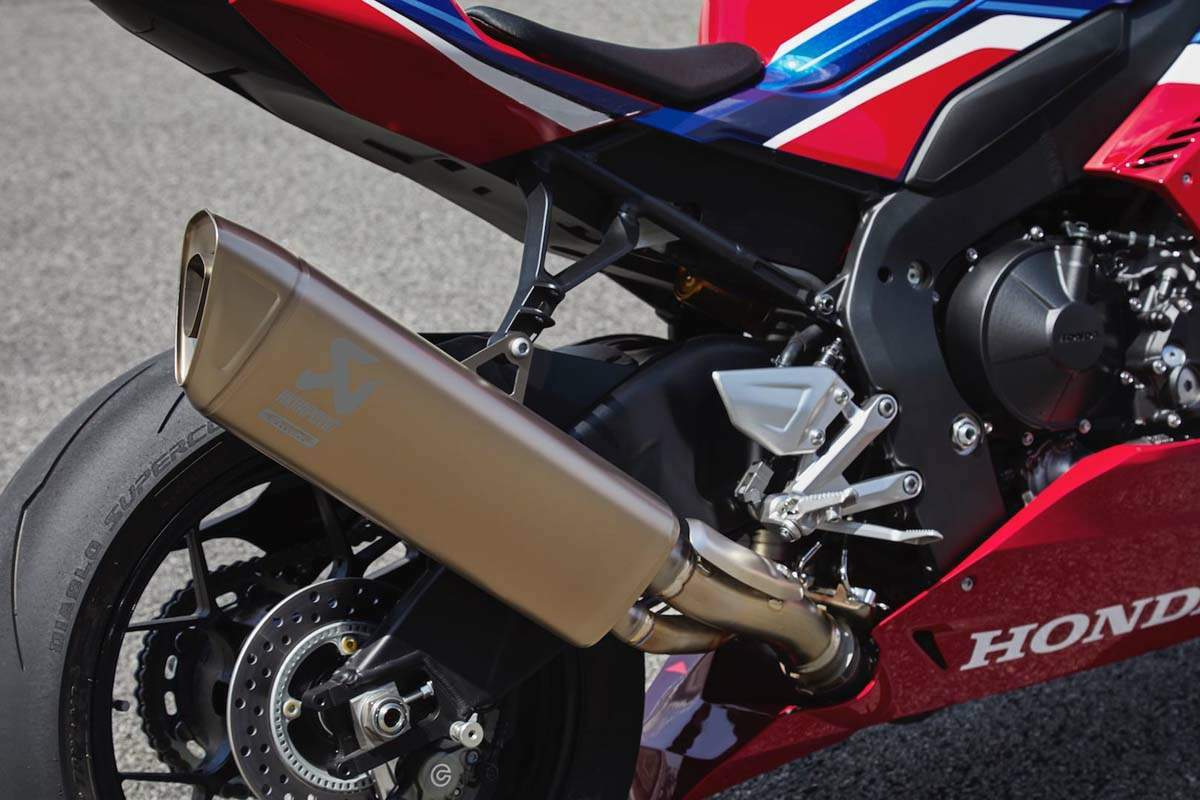
ELECTRONIC TECHNOLOGY
The 2017 model year CBR1000RR featured the first inline four-cylinder Honda engine to incorporate Throttle by Wire (TBW) technology. Derived and developed from the system used by the RC213V-S, it controls the throttle butterfly valve angle (relative to input from the throttle) to provide a linear delivery, putting precise throttle control—and a natural feel—in the rider’s right hand. The TBW system has been improved for more immediate response in part-throttle applications—such as gradual opening on corner exit—to minimize any delay in torque delivery.
There are three default riding modes, with options to change engine output and character. Power (P) operates through levels 1-5, with 1 giving ultimate outright power. Engine Brake (EB) manages performance on a closed throttle through levels 1-3, with 1 being the strongest engine braking.
It also manages Wheelie (W) through levels 1-3 (plus off), with 1 being the strongest. Wheelie control uses information gathered by the IMU on pitch angle, along with front and rear wheel-speed sensors, to maintain torque and deal with the wheelie without sacrificing forward drive. Honda Selectable Torque Control (HSTC) adjusts through 9 levels (plus off), with 1 giving weakest intervention. It has been optimized for the 2021 model and now includes a slip-rate control (when the slip-change rate, based on ratio of front/rear wheel speeds, exceeds predetermined values) to moderate rapid wheel spin and maintain traction. In conjunction with the existing outright slip control, HSTC is smooth in operation while delivering maximum confidence for the rider.
The CBR1000RR-R Fireblade SP is also equipped with Start Mode for race starts. It limits engine rpm at 6,000, 7,000, 8,000 and 9,000 rpm set-points, even with a wide-open throttle, letting the rider focus more on clutch release. A quick shifter is also fitted, with performance optimized for racetrack performance and reliability.
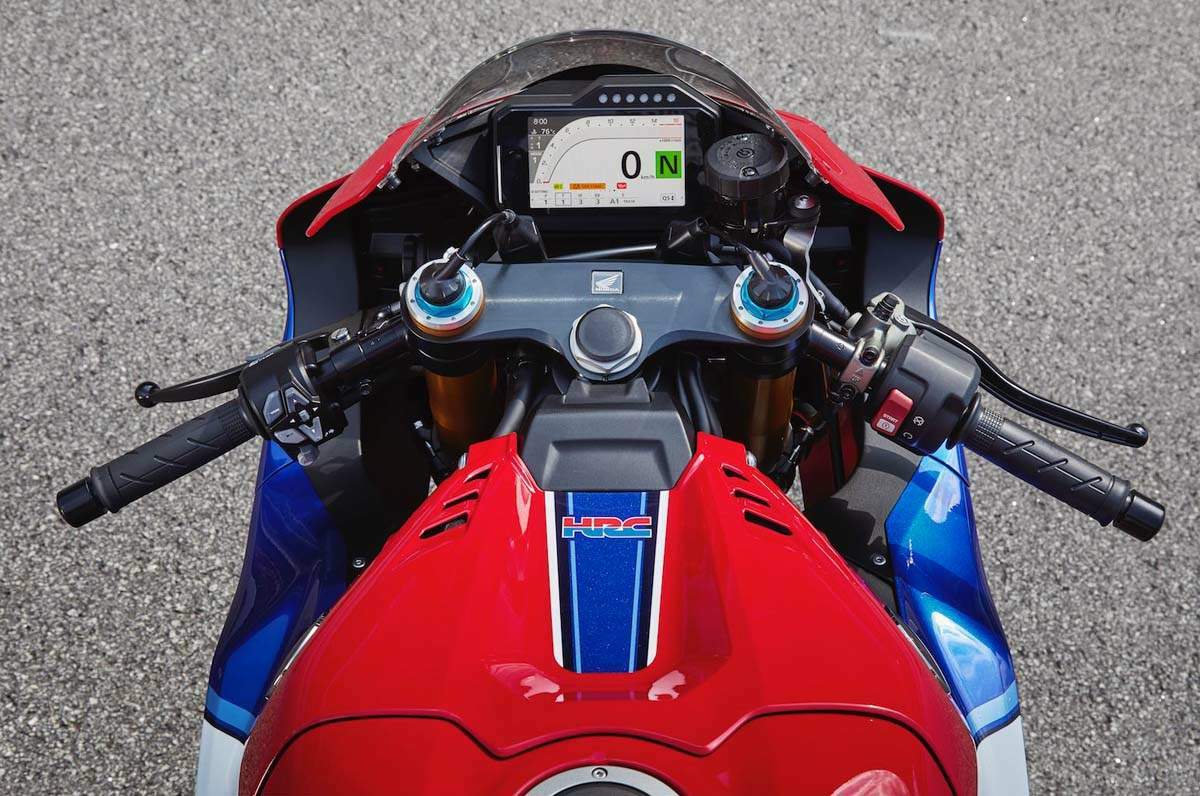
CHASSIS
The reduction in physical size of the CBR1000RR-R Fireblade SP’s engine opened up new packaging options around it for a new frame and swingarm. The chassis features completely revised geometry that provides even more accurate high-speed steering, improved tracking under acceleration and braking, and feel for front and rear grip on the limit. It excels at the very highest level of competition while providing a tremendous degree of comfort for street riding.
Frame The main frame is constructed from 2 mm aluminum and allows much more accurate tuning of the rigidity balance. Comprised of four components, the new main frame attaches to the engine in six locations to improve rigidity for even more precise handling. Vertical and torsional rigidity are increased by 18% and 9% respectively, with horizontal rigidity decreased by 11%—all aimed at maximizing rider feel.
Wheelbase is now 57.4 inches, with rake and trail of 24°/4.01 inches compared to the previous model’s 55.3 inch wheelbase, 23° rake and 3.77 inch trail. The new chassis delivers an even more solid feel during acceleration and high speeds, while retaining its precise handling character. Wet weight is 443 lbs. Balance and center of gravity have been revised; the crankshaft is 33 mm farther from the front axle and raised 16 mm. This evens out weight distribution, while the higher center of gravity reduces pitching and improves side-to-side agility.
Round, thin-wall aluminum tubing forms the minimal subframe. It also mounts to the frame from the top (rather than sides) to narrow the area around the rear of the fuel tank and seat, providing a compact (and aerodynamically efficient) riding position. Seat height is 32.6 inches, with the handlebar position moved forward (for leverage) and the foot pegs moved rearward and upward.
Suspension Stamped from 18 individual thicknesses of aluminum, the swingarm is 30.5 mm longer than the previous design, at 24.5 inches, but it weighs exactly the same. Its horizontal rigidity is reduced by 15%, with vertical rigidity maintained to generate grip and improve feel.
For optimum frame rigidity (and to save weight), the top of the Pro-Link® rear suspension now attaches to the rear of the engine block via a bracket, doing away with the upper cross-member. The design isolates the rear wheel from the headstock, improving high-speed handling and rear-wheel traction feel.
The Bosch six-axis IMU replaces the five-axis unit of the previous design; this allows more accurate calculation of pitch and roll for even more precise control. The CBR1000RR-R Fireblade SP is also equipped with Showa’s new Honda Electronic Steering Damper (HESD). A lightweight through-rod design that mounts on the bottom of the steering stem and attaches to the bottom triple clamp, HESD is controlled by input from the wheel-speed sensors and IMU; three levels of control are available.
Second-generation semi-active Öhlins Electronic Control (S-EC) is featured on the CBR1000RR-R Fireblade SP. The 43 mm Öhlins NPX fork uses a pressurized damping system to minimize cavitation, resulting in more stable damping control and improved bump absorption at racetrack speeds, as well as improved rider feedback from the front tire. Its length also offers greater freedom for geometry changes.
In conjunction with the hardware upgrade, the Öhlins Objective Based Tuning interface (OBTi) now offers much finer suspension adjustment front and rear; both can be set independently from the default settings, and three individual modes can be set and stored, allowing the rider to configure multiple settings for a track and switch settings instantly while riding.
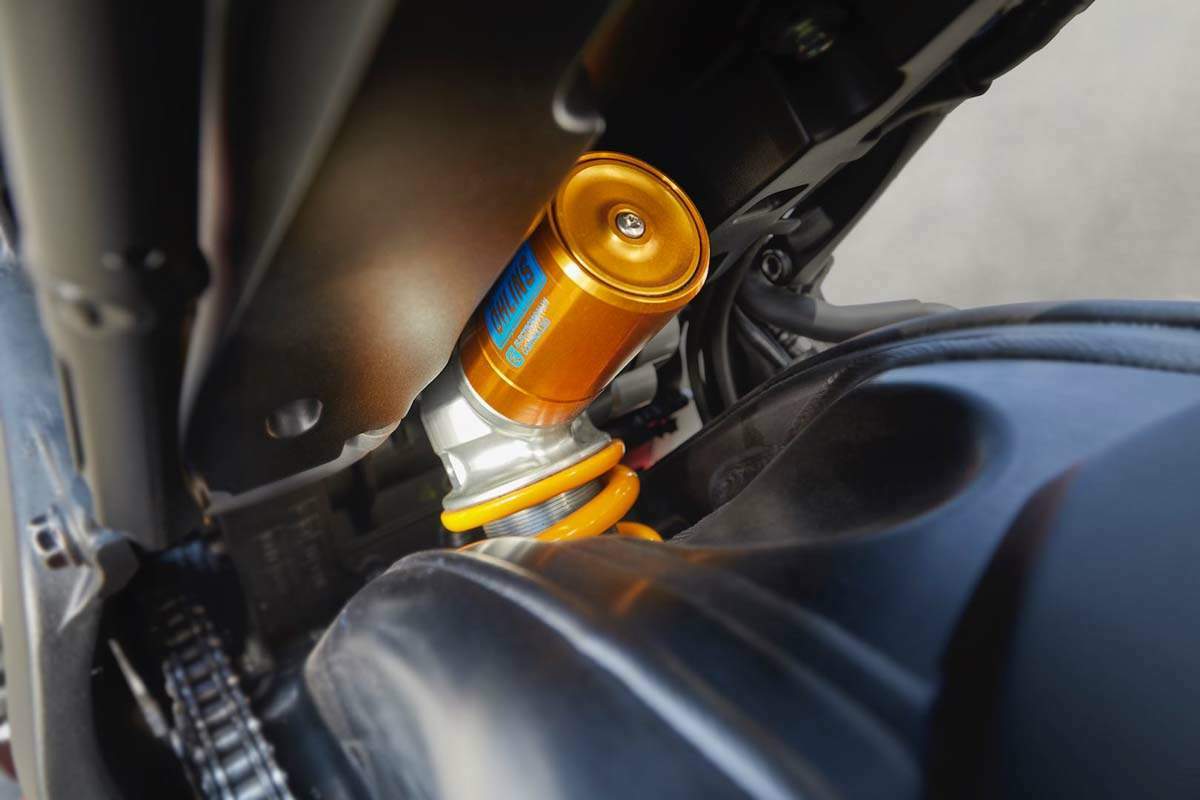
Brakes / Wheels
New Brembo Stylema four-piston radial-mount brake calipers are operated by a Brembo master cylinder and brake lever. They now grip 10 mm larger 330 mm diameter discs; the 5 mm disc thickness also dissipates heat more efficiently. The rear brake caliper is the same Brembo unit used by the RC213V-S.
Rear lift control and ABS-managed brake force relative to lean angle were a feature of the previous design. On the CBR1000RR-R Fireblade SP, the system gains two switchable modes; SPORTS mode focuses on road-riding performance, with high brake force and less pitching, while TRACK mode offers braking performance tailored to much higher speeds that are usually encountered in race conditions.
The 6-inch-wide rear rim features new hub geometry to save weight while maintaining rigidity. It mounts a 200/55-ZR17 tire (a size increase from the previous model’s 90/50-ZR17), minimizing the change in chassis geometry when switching from street to track rubber. The front rim holds a 120/70-ZR17 tire.
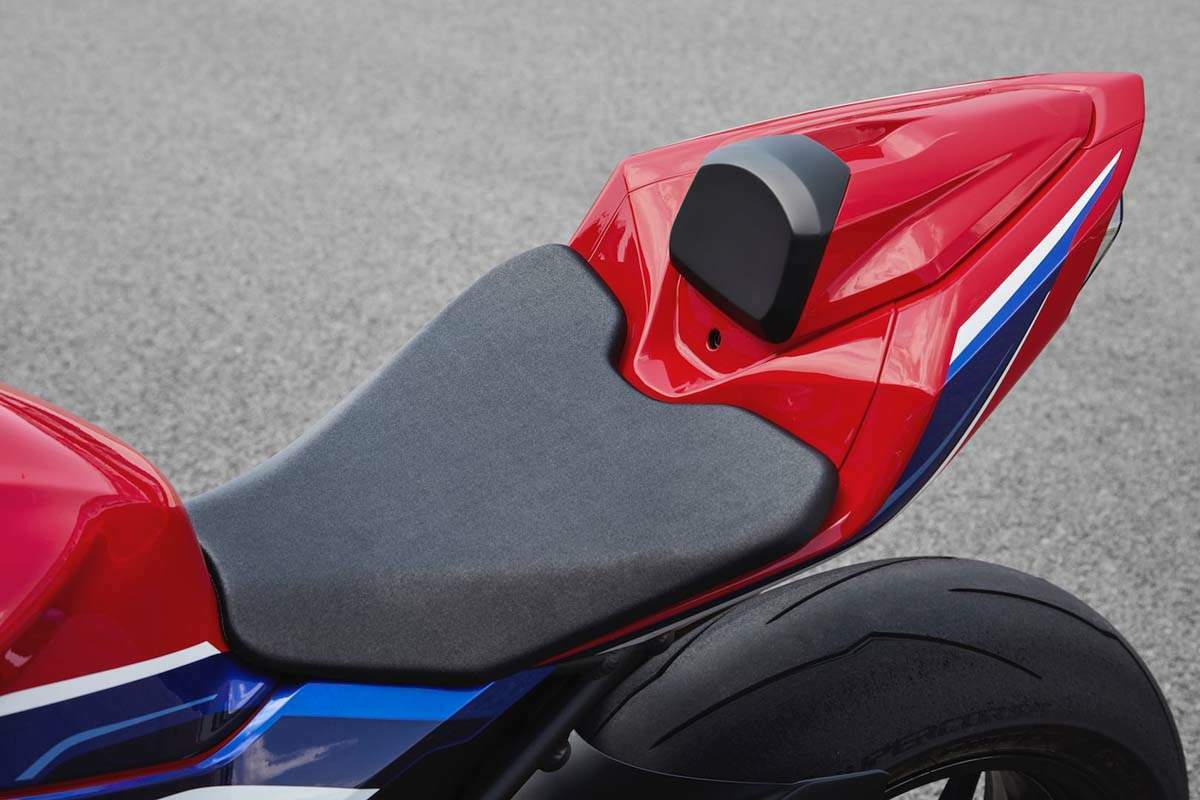
DESIGN / STYLING
Along with its new engine and chassis, the CBR1000RR-R Fireblade SP has an aggressive new fairing design. It’s no mere styling exercise however; the drivers in development were to create a class-leading drag coefficient (with a tucked-in rider under track conditions) and restrict lift under acceleration, while also improving braking stability.
The first part of the process was to lower the fuel tank cover by 45 mm (compared to the previous design), decreasing the frontal area with the rider prone. Set at a 35° angle, the windscreen smoothly channels airflow from the upper fairing over the rider and seat cowl, minimizing wind resistance and drag as much as possible. The left and right upper fairing slits reduce yaw and roll resistance while turning.
A convex surface on each side of the front fender makes steering easier by channeling airflow away from the front wheel and smoothly directing it to the fairing sides. Cooling air for the radiator and oil cooler is optimized by velocity and pressure management of the air flowing from the tire.
The lower fairing has been extended closer to the rear tire and shaped to channel air downward. On the track, this has two effects: In dry conditions, less air hits the tire, lowering drag; in the wet, less water hits the tire, improving grip. To let air flow around the rider’s feet with minimum resistance, the sides of the rear hugger are carefully shaped while its upper side is cut-out to vent air that channels up from underneath either side of the swingarm, decreasing rear lift. The net result of all this work, with the CBR1000RR-R Fireblade SP in stock race trim, is a best-in-class drag coefficient value of 0.270.
Winglets To generate downforce at track speeds—and maintain the smallest possible frontal area—winglet structures effectively generate the same downforce as the 2018 RC213V MotoGP machine. The results are a reduction in wheelies under acceleration and increased stability on braking and corner entry.
Three wings are arranged in a vertical line inside both left and right fairing ducts. This arrangement (vertically deep and longitudinally shallow) has no detrimental effect on yaw and roll ability during corner entry. And the consistent distance between the trailing wing tips and the inner fairing wall limits separation of the airflow, producing maximum downforce.
The wing angle balances opposing right/left downforces from the dihedral and twist angles when yaw occurs through a corner, for stable behavior. Flow-speeds over the top and below the wings differ, to prevent air from getting “trapped” on the fairing sides and affecting handling.
Dash For full and intuitive control of the CBR1000RR-R Fireblade SP’s systems, the full-color 5-inch TFT screen is larger, has higher resolution and is fully customizable to show exactly what the rider wants to see. The compact left-hand switchgear houses a four-way switch. Fast and easy to use, it has top/bottom buttons to set riding-mode parameters, while the left/right buttons cycle screen display information.
Honda’s Smart Key System has been added. The ignition now operates without having to insert a key, as does the handlebar lock. This is both convenient in day-to-day use and has allowed use of a competition-style top triple clamp while freeing up optimum space for the ram-air system.
One-year, transferable, unlimited-mileage limited warranty; extended coverage available with Honda Protection Plan.
Meets current EPA and CARB standards
2021 Honda CBR1000RR-R Fireblade SP – Totalmotorcycle.com USA Specifications/Technical Details US MSRP Price: starting from $ See Dealer for Pricing in USD Canada MSRP Price: $ See Dealer for pricing in CDN Europe/UK MSRP Price: £ GBP (On The Road inc 20% Vat) ENGINE Type 999cc liquid-cooled in-line-four-cylinder four-stroke Valve Train DOHC; four valves per cylinder Bore x Stroke 81.0mm x 48.5mm Compression Ratio 13:1 Induction PGM-FI; 52mm throttle bodies Ignition Digital transistorized w/ electronic advance Starter Electric Transmission Manual 6 speed Clutch Multiplate wet Final Drive 16T/43T; #525 chain SUSPENSION Front Öhlins NPX 43mm telescopic fork w/ Electronic Control (S-EC); 4.9 in. travel Rear Pro-Link® system; single Öhlins shock w/ Electronic Control (S-EC); 5.6 in. travel BRAKES Front Two 330mm discs w/ Brembo Stylema 4-piston radial-mount hydraulic calipers; ABS Rear Single 220mm disc w/ Brembo hydraulic calipers; ABS TIRES Front 120/70-17 Rear 200/55-17 MEASUREMENTS Rake (Caster Angle) 24º Trail 102mm (4.0 in.) Length 82.7 in. Width 29.3 in. Height 44.9 in. Seat Height 32.6 in. Ground Clearance 4.5 in. Wheelbase 57.3 in. Fuel Capacity 4.3 gal. Color HRC Tricolor Curb Weight* 443 lbs.
*Includes all standard equipment, required fluids and full tank of fuel—ready to ride Meets current EPA and CARB standards Models sold in California meet current CARB standards and may differ slightly due to emissions equipment Specifications subject to change
|
Any corrections or more information on these motorcycles will be kindly appreciated. |